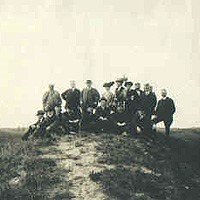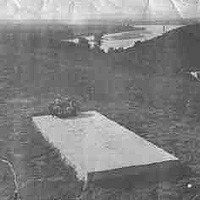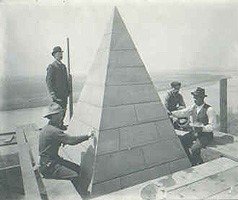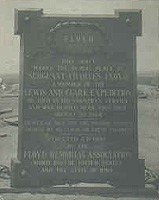Floyd Monument
Sergeant Charles Floyd is best known as the only member of the crew to die during the Lewis and Clark Expedition, and the first United States soldier to die west of the Mississippi. Floyd was born in Kentucky around 1782. In 1803, he joined the Corps of Discovery, the military expedition that would explore the Louisiana Territory.
On the night of August 19, 1804, as the explorers reached the area just south of Sioux City, Floyd became seriously ill with "bilous cholic.” Although expedition leaders did everything they could to help the young soldier, Floyd became weaker. At the last, he told Captain Clark, "I'm going away and I want you to write me a letter." He died sometime after 2:00 in the afternoon on Monday, August 20, 1804.
Captain Clark read the funeral service for Charles Floyd and noted in his journal: "We buried him on the top of the bluff Mile below a Small river to which we Gave his name, he was buried with the Honors of War, much lamented." Patrick Gass, another member of the expedition noted that they buried him "in the most decent manner our circumstances would admit." His grave was marked with a cedar post with the inscription "Sergt. C. Floyd died here 20th of August 1804."
It is now believed that what was described as "bilous colic" was likely appendicitis. At that time in history, there was no cure for that disorder, and Floyd would likely have died even in the best hospital.
Two years later, as the expedition returned from the mouth of the Columbia River, the men visited the site of Floyd's Grave. They found it had been disturbed, perhaps by animals. They restored the grave and replaced the fallen cedar marker.
In the years that followed, Floyd's Bluff and the cedar post became a landmark for white travelers in the area. The famous painter George Catlin later painted the gravesite while passing through the area in 1832.
Over the years, the Missouri River eroded Floyd's Bluff, and rain eroded the end of the grave, washing away the cedar post. In 1857, concerned citizens of the little town of Sioux City recovered what remains they could find and placed them in a walnut coffin. They buried the coffin 600 feet back from the river and remarked the grave.
In 1894, Floyd's Journals of the Lewis and Clark Expedition were rediscovered, renewing interest in the young soldier and his gravesite. However, for nearly forty years cattle had trampled the grave and souvenir hunters had carved away the wooden markers. It took considerable searching, but the grave was rediscovered on Memorial Day 1895.
His remains were placed in two earthenware urns and reburied again on August 20, 1895. The citizens held a special re-interment service. This time a marble slab, four feet by eight, was placed over the grave. The Floyd Memorial Association was also formed in 1895 for the purpose of honoring Sergeant Floyd in a more fitting way, with a permanent monument in his memory.
The Memorial Association secured $13,400 from the United State Government, the state, the county and other private sources. Colonel Chittenden of the United States Engineer's Office in Sioux City, donated his services. The railroads even transported the materials free of charge.
Construction of the monument took about a year. The foundation was laid on May 29, 1900. The cornerstone was laid with a great deal of ceremony on August 20, 1900, on the ninety-sixth anniversary of Floyd's death. The umbrellas in the photograph are for protection from the heat.
The Floyd Monument is an Egyptian-style obelisk, 100 feet high and built of Kettle River sandstone. It is capped with aluminum connected to copper grounding wires as protection from lightning strikes. It has a solid concrete core in which Floyd's remains are sealed.
The capstone was placed at the top on April 22, 1901, and the Dedication was held on Memorial Day, May 30, 1901. Thousands attended the dedication ceremonies, and many came by a special train that was provided free by the Sioux City and Pacific Railway Company.







